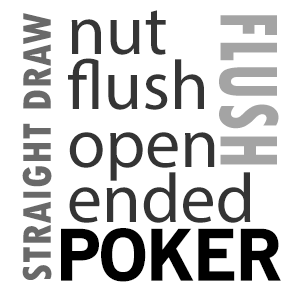Poker Hand Strength: Just How Good is your Hand?
In this lesson we take a look at the different hands we may hit on the flop. Just what is the strength of those poker hands and how do you play with them to ensure you extract maximum value from your winning hands or don’t fall down a trap? Some may appear stronger than they actually are and there are many factors to consider when deciding how to play with them after the flop.
Flopping Nothing
This will be a common occurrence, and if this happens you will have a decision to make whether to carry on or not.
You have the following options:
- Check or Fold – Check in an attempt to see a free card, but fold to any bet
- Continuation – If we have shown strength before the flop we can make a continuation bet in the hope of taking the pot there and then
Which of the above options we take will depend on the strength of our hand (even though we haven’t hit on the flop) and also the read we get on our opponent, if the read we get suggests he has hit the flop then it is more likely we will fold to any bet, if he appears weak and we think he may also have missed the flop then we may go for the continuation bet and try and take the pot.
Flopping a Draw
The two main drawing hands you will be facing are the Open Ended Straight draw, and the Flush draw.
Now we know from the poker maths section that we will only play draws if the odds are in our favour. So if our opponent acting before us bets then we use our poker maths to work out the odds and only play if the odds are in our favour.
If we are in late position and our opponent checks into us, then we can either just take a free card to try and hit our draw, or we can try and take the pot there and then with a continuation bet if we have shown strength before the flop.
It gets a little more complicated when we have to act early before our opponent, we have very little information on whether our opponent has hit anything on the flop, so all we can do is look at his betting pattern before the flop and decide if the flop fits in with the kind of hand we think he has. Then we have the following options:
- Continuation Bet – If we were the aggressor before the flop we can try and take the pot now with a continuation bet and hope that our opponent has not hit anything on the flop.
- Limitation Bet – This type of bet is to try and limit the amount of the bet in order that we get the correct odds for our draw. Acting first, we would make this type of bet in the hope that our opponent does not raise, if he just calls then we are getting the correct odds to play our draw, if he folds then we take the pot there and then. If he does raise then we now have more information about his hand as he has indicated strength, and we still have the opportunity to get out of the hand if we wish.
- Check – We can also just check and hope for a free card, however we run the risk here of being priced out by a bet from our opponent, but this is fine, if we don’t have the odds then we won’t play.
Don’t chase draws unless you have the correct odds to do so. If you are priced out of it then fold your hand and wait for the correct opportunity.
Remember, the goal is to make better decisions than your opponents — over time, this can give you an edge. But if we chase cards without the right odds, we’re more likely to be the ones making costly mistakes.
Flopping a Pair
This should be quite a common occurrence but a pair alone is not a particularly strong hand. There are lots of ways our opponent can have us beat, he may be holding a pocket pair higher than the top pair on the flop, he may have hit 2 pair, he may have hit a set, straight, flush … the list goes on.
Now some of these hands, such as the straight or flush we can rule out from looking at the texture of the flop, but most of the other hands are disguised and we only have the betting patterns of our opponent to try and put him on a hand.
So it is for the reasons above that we play cautiously with only a single pair.
- Top Pair – Despite all the caution above, this is a reasonably strong hand, and there is a reasonable chance that we are in the lead, so we should assume we are in the lead and use a value bet until we get any conflicting information from our opponent that suggests he may have us beat.
- Middle and Bottom Pair – We shouldn’t really be very interested in these, they are very weak hands that are easily beaten. We can make a probe bet here to get some information from our opponent, but at the first sign of strength we want to fold and get out of the hand.
Flopping Two Pair
Two pair is a relatively strong hand, and in many situations it may give you a good chance of being ahead. This makes it a good opportunity to build the pot — while still being alert to board texture and how your opponent might improve.
However, we still need to play the hand correctly to maximise our chances of winning a good pot and to protect our hand.
It is very unlikely that we are going to improve our hand, we will only improve our hand to a full house 17% of the time, so the chances are that if we are going to win this hand then we will do so with two pair.
So we have to keep an eye out on the texture of the flop for opportunities for our opponent to improve their hand to one that can beat our two pair, and in those situations make sure our opponents don’t have the correct odds to call draws.
There are 3 types of two pair we can flop.
Top Two Pair
We are almost certainly leading at this stage, It is unlikely that our opponent has hit top or middle set (as we are holding two of the cards available), there is a small chance that they have hit bottom set, but we can be reasonably confident that we are in the lead.
So our goal here is to build the pot up and extract as much money from our opponent as possible. I would recommend a simple value bet here, and would bet slightly more if there is any indication of a straight or flush draw on the texture of the flop.
Bottom Two Pair
We will use similar aggression here to Top Two Pair. In this situation we are hoping that our opponent has flopped top pair, as our opponent will only have 5 outs in which to beat us and will probably be prepared to put some money into the pot.
Top and Bottom Pair
Surprisingly out of the three, we are most vulnerable with Top and Bottom pair. This is because if our opponent has top pair then he has an extra out with the chance the middle card could pair on the board which would counterfeit our top and bottom pair giving us both Top two pair, and the likelihood of our opponent having a higher kicker.
E.g. We hold A 5
5 and our opponent holds A
and our opponent holds A Q
Q , the flop comes down A
, the flop comes down A 9
9 5
5 , now if any 9 comes on the turn or the river our two pair is now counterfeited and both us and our opponent hold top two pair, but we only have a 5 kicker and he has a Q kicker so he has the winning hand.
, now if any 9 comes on the turn or the river our two pair is now counterfeited and both us and our opponent hold top two pair, but we only have a 5 kicker and he has a Q kicker so he has the winning hand.
We still hold a very strong hand with Top and Bottom pair, however because of this extra out our opponent has, we will play this hand very aggressively and make our opponent pay to see any further cards.
This is often a good spot to take the pot early and reduce the risk of being outdrawn. I would recommend a pot sized bet here.
Flopping a Set
A Set is where we hold a pocket pair in our starting hand, and we hit the third card on the flop to give us three of a kind. This is a really powerful hand mainly because it is very disguised and our opponent most probably won’t have a clue that we have hit a set, and may well think he is in the lead with a weaker hand.
So again we want to get as much money into the pot without scaring our opponent off, whilst also protecting our hand against any possible draws that could beat us.
- If there is a Straight or Flush Draw on the flop – Bet aggressively and make sure we don’t give our opponent the correct odds to call, if they do, then they’ve made a mistake — and over time, making better decisions than your opponents can give you an edge.
- If we think our opponent has hit something – Lead out betting with a value bet or a slightly higher bet, then we are hoping that our opponent, who may have hit top pair and be thinking he is in the lead, raises us.
- If we think our opponent hasn’t hit anything – In this situation we may want to continue to disguise the strength of our hand by checking in the hope that this will induce a bluff from our opponent, who otherwise wouldn’t of put any money into the pot if we had bet. If we do end up giving our opponent a free card here, this is not a problem as we are hoping that our opponent hits some sort of hand, which doesn’t beat us, but which encourages him to put some money into the pot on the next round of betting.
Flopping Trips
Trips is where a pair comes down on the flop and we hold the third card in our hand to make 3 of a kind. The only difference between Trips and a Set is that Trips is not disguised and our opponents will be aware not only of the possibility that we have the third card in our hand but also the possibility of a full house.
This will mean that our opponents will be much more reluctant to commit chips into the pot, so we want to try and ensure we don’t scare them off.
However a lot of players often attempt a bluff when they see a pair on the board, so quite often we can slow play this sort of hand in the hope of inducing a bluff from our opponent. The other option is to make a small bet similar to a probe bet and see if any opponent bites.
As always check the texture of the flop for any draw possibilities and if there is any, then always play your hand aggressively to protect it.
You shouldn’t expect to win a very large pot with Trips, as it is so obvious. However against a bad player who has hit top pair or similar we may get lucky.
Flopping a Straight
Again, this is a very strong hand, but the straight possibility will also be very obvious to our good opponents.
There are two types of straight we can flop:
- High End – Highest possible straight (e.g. Our Hand 9, 10 – Flop 6, 7, 8)
- Low End – Lowest straight (e.g. Our hand 4, 5 – Flop 6, 7, 8)
In general it is better to bet these hands rather than slow play:
- High End – I recommend a bet here rather than slow playing, because there are so many scare cards (for your opponent) that can come on the turn which will prevent him betting later on, so we should try and get some money in the pot now if we can. A value bet of about ½ the pot is good here, or a little more if you are playing against a loose opponent or you think your opponent has hit top pair or similar.
- Low End – Here we should play very aggressively to protect our hand and also test if our opponent has the smart end of the straight. if you get raised he probably has it, if you get called this may also be a sign he has it and is slow playing it. About a pot sized bet here would be about right.
Flopping a Flush
It is very unlikely that you will flop a flush (1 in 119 times), it is much more likely that you will flop a draw to a flush. When you do flop a flush it will be very hard to get action as people will be very unwilling to bet when 3 cards of the same suit come down on the flop.
Our best chance of winning a decent pot here is if our opponent has hit a lower flush than ours
- Nut Flush / High Flush – slow play and hope that your opponent has hit or will hit a lower flush.
- Lower Flush – play more aggressively to protect your flush against anyone holding a draw to a better flush. If you get raised or your opponent bets into you aggressively you have to consider that he may have a higher flush than you, and you may need to throw the hand away.
Flopping a Full House
A great flop for you! However, once again your opponent may be wary because of the pair showing on board.
The best way to play a full house is to make a small to medium sized value bet and hope that your opponent has caught something on the flop which tempts them to play.
Against a very tight player who will fold to any bet, slow play and hope he catches up a little on the turn which will tempt him to bet.
If there is a draw on, then we want to try and give the right odds for our opponent to call, so make sure your bet is small enough to give those odds. If our opponent hits their draw then this could lead to a very big pot for us, with our Full House still in the lead.
Flopping Four of a Kind
First, stay focused — even with a monster hand like this, it’s important to think carefully about how to get value without giving away your strength.
Generally the best way here is to slow play and hope that someone gets involved in the pot betting with a weaker hand or with a bluff. If someone does bet into you, then just call, don’t reveal your strength yet. After the turn or river we can start to look to raise and build the pot up a bit more.
Poker Bankroll Challenge: Stage 5
- Stakes: $0.02/$0.04
- Buy In: $4 (100 x BB)
- Starting Bankroll: $63
- Target: $20 (5 x Buy In)
- Target Bankroll: $83
- Estimated Sessions: 5
Use this exercise to consider the real strength of your hand and how to extract the maximum value out of all pots where you have the winning hand. Don't forget the other foundations of your strategy though, we are building step by step and you should now be consolidating all your new knowledge in the way you play at the tables.
Practise what you’ve learned with the Bankroll Challenge — a structured, hands-on way to build good habits and responsible bankroll management. Goals shown are for illustration only; results will vary.









